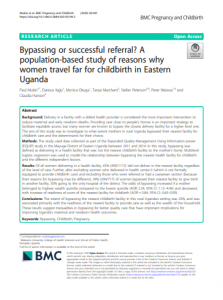
Background
Delivery in a facility with a skilled health provider is considered the most important intervention to reduce maternal and early newborn deaths. Providing care close to people’s homes is an important strategy to facilitate equitable access, but many women are known to bypass the closest delivery facility for a higher level one. The aim of this study was to investigate to what extent mothers in rural Uganda bypassed their nearest facility for childbirth care and the determinants for their choice.
Methods
The study used data collected as part of the Expanded Quality Management Using Information power (EQUIP) study in the Mayuge District of Eastern Uganda between 2011 and 2014. In this study, bypassing was defined as delivering in a health facility that was not the nearest childbirth facility to the mother’s home. Multilevel logistic regression was used to model the relationship between bypassing the nearest health facility for childbirth and the different independent factors.
Results
Of all women delivering in a health facility, 45% (499/1115) did not deliver in the nearest facility regardless of the level of care. Further, after excluding women who delivered in health centre II (which is not formally equipped to provide childbirth care) and excluding those who were referred or had a caesarean section (because their reasons for bypassing may be different), 29% (204/717) of women bypassed their nearest facility to give birth in another facility, 50% going to the only hospital of the district. The odds of bypassing increased if a mother belonged to highest wealth quintile compared to the lowest quintile (AOR 2.24, 95% CI: 1.12–4.46) and decreased with increase of readiness of score of the nearest facility for childbirth (AOR = 0.84, 95% CI: 0.69–0.99).
Conclusions
The extent of bypassing the nearest childbirth facility in this rural Ugandan setting was 29%, and was associated primarily with the readiness of the nearest facility to provide care as well as the wealth of the household. These results suggest inequalities in bypassing for better quality care that have important implications for improving Uganda’s maternal and newborn health outcomes.